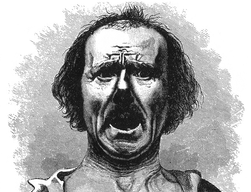Currently, the concept of Hysteria? Dissolved in other diagnoses. Previously, during the 19th century, the term became very popular because it was a common diagnostic disorder, mainly among women. Jean-Martin Charcot, Freud’s mentor, defined the male hysteria of his time by very clearly describing cases, with the aim of “defeminizing” this condition.
If there is one thing curious, it is how history tends to divide certain categories, disorders or dimensions by sex, involving them in a certain gender.
- Thus.
- Any sign of instability.
- Emotional overflow.
- Nerve disturbances accompanied by migraines.
- Abdominal pain.
- Depression.
- Etc.
- Had for a long time a clear feminine exclusivity.
In the 18th century it was fashionable to be a hysterical man, people have sought to hide more refined, sensitive and civilized behaviors under this term.
It was perhaps not known that Sigmund Freud had tried to convince the Vienna Medical Society in 1886 of the existence of male hysteria and the clinical label he had defined at the time.
However, his colleagues did not want to accept or pay attention to this diagnostic dimension inherited from Hippocrates and originally evoked how? Supposedly the female uterus has even changed the behavior and will of the woman.
How can we accept that the male gender can exhibit the same altered nerves, somatizations, and dissociative behaviors?It seems that male hysteria existed and exists, but this whole set of symptoms is currently being collected under other more appropriate clinical labels.
A study from the University of Toronto and published in the European journal of Neurology explains that the concept of?Hysteria, he’s been with us for over four thousand years. There are Egyptian papyrus who talk about the phenomenon of the “uterus at war”. and how this organ can reach a woman’s throat, if she is very passionate and suffers sexual deprivation.
The first historical reference we find about male hysteria appears in a work by William Shakespeare: King Lear himself defines his anguish as that passionate pain generated by hysteria; later, it was not until the 19th century that Jean-Martin Charcot concentrated his interest in this dimension between 1865 and 1893.
To do his work he relied on other professional colleagues, such as Paul Briquet and his book Clinical and Therapeutic Treatments in Hysteria.
This treatise left out the relationship between hysteria and the uterus to talk about a mental disorder that, for Dr. Briquet, had a brain origin, defined the disorder as a “brain neurosis” and said it also affected both men and women. Woman.
Although Charcot and Freud tried to be impartial in describing the symptoms of hysteria without differentiating women from men, the idea in general was different: hysterical women, for example, had passionate, very emotional and sexually deviant behaviors.
Therefore, male hysteria attributes to the male sex the most stereotypical female traits: sensitivity, emotional changes and effeminate behaviors.
Similarly, out of curiosity, we learned in the 19th century that male hysteria had its origins in anguish. A deep concern not to clearly manifest the attitude and “male” roles required by the company. Now, from a clinical and objective point, Charcot has defined male hysteria as follows:
It is important to note that, for Charcot, there was no difference between female and male hysteria, as we have said. Sigmund Freud later took his legacy and immersed himself in the concept of trauma; however, she preferred to concentrate on female hysteria at all times.
Who read the book? Dalloway? Virginia Woolf will no doubt recognize the term male hysteria. In this 1925 novel, Woolf describes the term by associateing it with a more clinically adjusted idea.
The term was used to describe traumatized men returning from war, in fact, it was precisely because of these situations in which thousands of young people returned without being able to react that they began to use another term: “The howitzer crash. “
Gradually, the hysteria label has been changing to suit clinical realities, so neurosis, conversion disorder or post-traumatic stress disorder give a better idea of these types of symptoms, which certainly appear in both cases. However, traces of this pejorative and misogina categorization remain.
In conclusion, it should be noted the great evolution of this term, after all, behind this female and male hysteria, there was a person unable to assimilate the trauma, a latent anxious person who did not know how to channel or express their emotions.

